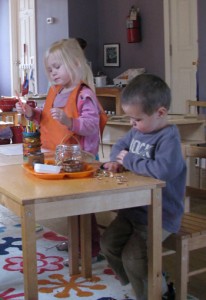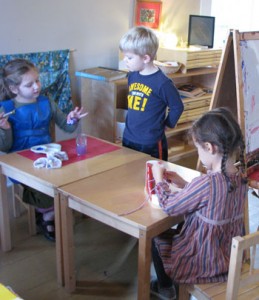Second in a two-part series. Read part one here.
Sunlight pours gently through the windows, buttering with a mellow glow the child-size hardwood furniture that populates the school. Brighter still, moving among and lighting upon tables, easels, benches and shelves of materials are some 15 youngsters – the class of 3, 4 and 5-year-olds at Bluebird Montessori in Silverton.
A certain mystery remains around the educational model developed by Dr. Maria Montessori (1870-1952), who devoted her life to teaching children, beginning with the “un-teachable” at a children’s psychiatric hospital where she worked.
In the last few years, Silverton stepped through the Montessori mystery with the formation of two Montessori schools – one private; one public – that together provide education from preschool to the sixth grade.
In 2008, Jennifer Traeger and Jacquie Curtis took turns driving their preschoolers to a Molalla Montessori. They were crestfallen when they learned it was closing.
“We had really bought into the whole idea – of community; of self-direction and independence,” Jennifer Traeger said. Matt and Jennifer Traeger, with Ross and Jacquie Curtis, decided to start their own preschool-kindergarten in Silverton and scrambled all summer outfitting Bluebird Montessori’s first home – in the Curtis’ basement.
They secured Teri Therkelsen of Mount Angel, who became a founder and the school’s teacher.
“She was in the last months of intensive year-long training when Jacquie and I convinced her to join us,” Jennifer Traeger said. “All of these people sacrificed a lot for this school, but we believe in it so much that we were willing to do it. We threw in some personal savings, sought out the lowest-priced materials, made a lot of things ourselves – and Teri took a very modest salary that first year.”
Bluebird Montessori opened its doors in September 2008 with eight students, all 3 to 4 years of age. The following summer found them moving to a larger space – on Jersey Street. This year there are 20 students.
During this time, they were also supporting the formation of Silver Falls School District’s first charter elementary Montessori and are among its founding members.
Community Roots School opened for grades 1-5 on the vacated Monitor School campus in the fall of 2009. In September 2011 the school moved to a portion of “the old high school.” With its further expansion next fall, Silverton will boast two Montessori schools that together serve kids age 2 ½ though the sixth grade.
“You know, it’s Silverton,” Therkelsen said. “It’s testimony to the open-minded, forward-looking people here. It’s a great community.”
For all their shared philosophy and passion, Bluebird and Community Roots are two separate and different entities, and enrollment in the privately owned preschool does not guarantee entrance to the public elementary school, said Miranda Traeger, Community Roots School Administrator and a founder.
A public charter Montessori
school in the Silver Falls School District
serving grades 1-5, and 1-6 in Fall of 2012
330 N. James St.
503-874-4107
[email protected]
www.crmontessori.org
Bluebird Montessori
Private school serving children 3-6
208 Jersey St.
503-881-9593
[email protected]
www.bluebirdmontessori.com
“It’s a public entity, open to everyone,” Miranda Traeger said. “If there are more applications than we can take we use the lottery method.”
At Bluebird Montessori, Ava Harris puts on a smock and gathers paper, markers and color pencils, which she sorts at her perch – a smooth table 2 feet square and as high. For the next 15-20 minutes, her attention is riveted on the sheet of paper upon which she draws, kicking aside a chair in favor of full-body involvement, hardly aware of the activity around her. Most of the kids are similarly absorbed, whether grinding coffee or grating nutmeg in the Practical Life area, handling wooden pieces to learn math or snuggling up with a good book in the Reader’s Roost.
It takes a prepared environment to develop this single-minded, often joyful state of immersion or “flow” hailed in psychological circles as the ultimate in harnessing the emotions in the service of performing and learning.
Because concentration is a chief Montessori tenet, Therkelsen and assistant teacher Heather Kofstad purposefully set up continuous flow opportunities, allowing student as much uninterrupted time as they need to perform their “work” for the day.
“If a child wants to observe something another child is doing, he stands quietly, hands behind him,” Therkelsen said. She will not interrupt an engrossed child while moving about the classroom to deliver one-on-one custom-designed lessons to each child. Even group times are optional.
“I don’t herd them all together and say, ‘OK, today we’re all going to learn the sound of the letter A,” Therkelsen said. They keep a low profile – both figuratively and height wise – watching for cues of readiness.
Further, it is about the physical space, and children derive a sense of security from a tidy, organized environment where they know where things are, Jennifer Traeger said.
“Conventionally, school runs by the clock,” she explained. “Children zero to six understand organization by space and have no concept of how time works.”
If a student wishes to speak to a teacher otherwise engaged, he or she places a hand upon the teacher’s shoulder, waiting quietly.
“What I love about Montessori is that it honors the individual child,” Therkelsen said.
“Teri is a child whisperer,” Jennifer Traeger said. “She understands very well what makes individual children tick; she’s meant to be a Montessori teacher; she is peaceful and respectful. She’s never telling the children what to do, but suggesting, and they perk up and follow what she has to say.”
To refrain from interrupting; to respect someone else’s concentration and take a more patient approach when you want someone’s attention are worthy skills that generally equip a child for a smooth transition to public school.
“When I was introduced to the concept as an adult I started analyzing how many times I interrupt adults in their natural flow and process,” Miranda Traeger said. “(Montessori) is a great journey for the kids but it’s phenomenal one for the adults.”
In its second year, the 58 children at Community Roots School, Miranda Traeger said, have done well in state testing.
“They’re kids; they need motivation and encouragement from time to time,” she said. “But it’s phenomenal to be part of an organization that trusts children and that they will, with some guidance and structure, really make some great decisions that enhance their own educational experience.”
People do not speak often enough of the program’s materials, she said.
Maria Montessori designed wooden maps, colorful bead cabinets and other tangible tools that teachers introduce at an early age and then grow with students, further embedding their understanding by using familiar tools in increasingly complex ways.
“In the continuum of Montessori, everything is very purposeful,” Miranda Traeger said. “So when you see a child at the Children’s House (Montessori term for a preschool) doing lots of polishing or other fine motor stuff with their hands, it’s not just because it meets the need of what they’re doing right now. It is actually leading them to have the motor skills to, say, hold a pencil correctly and move forward. At the elementary school level, students are transitioning from the essential years of ‘sensory work’ to putting their skills into practice in new ways and in more small-group settings.”
“I think in our society we don’t give kids – young kids especially – enough credit for what they’re capable of,” Miranda Traeger said. “They’re very capable little creatures and we just need to give them the opportunities to practice it.”
